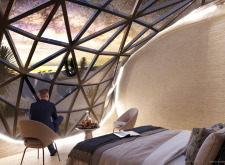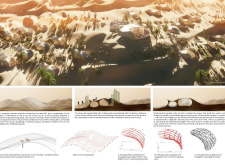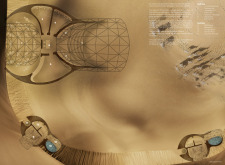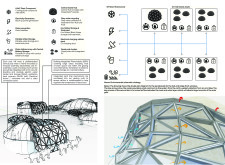5 key facts about this project
The design is located in the dune landscapes of a desert, aiming to create living spaces that are integrated with nature. The project emphasizes sustainable construction practices by using local materials and biological processes. The goal is to build structures that respect the environment and connect people to the desert landscape.
Construction Methodology
Sand serves as the main building material, combined with a mixture that includes yeast, urea, calcium chloride, water, and *Bacillus pasteurii*. This combination allows the loose sand to become solid and suitable for construction. By using natural materials and incorporating living organisms into the process, the design demonstrates a commitment to environmental sustainability.
Pod Design
Living pods are designed to fit the shape of the sand dunes, creating a relationship between the structures and their surroundings. Each pod features a straightforward layout that offers wide views of the desert and local wildlife. There are different types of pods, including more spacious options for guests, which include amenities like private pools and shaded terraces. These elements enhance comfort while encouraging relaxation in the natural environment.
Sustainability Measures
Sustainability is central to the design, with an emphasis on modular construction. This approach allows the structures to be easily moved or repurposed when no longer needed, minimizing their impact on the landscape. Features such as systems for recycling grey water and treating waste also contribute to a lower environmental footprint.
Environmental Integration
The design includes strategies for managing the relationship between buildings and the desert climate. Natural airflow is carefully considered, with designs that help regulate interior temperatures. By focusing on ventilation and the use of sunlight, the architecture responds thoughtfully to the challenges posed by the environment. This result is a more comfortable living space that aligns with the natural world.
The open spaces framed by the organic forms invite people to take in the beauty of the desert. Each structure serves as a reminder of nature’s rhythms, allowing occupants to appreciate the landscape and its ever-changing aspects.






















































